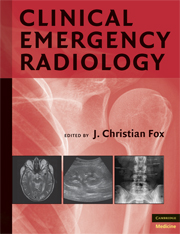Book contents
- Frontmatter
- Contents
- Contributors
- PART I PLAIN RADIOGRAPHY
- PART II ULTRASOUND
- 12 Introduction to Bedside Ultrasound
- 13 Physics of Ultrasound
- 14 Biliary Ultrasound
- 15 Trauma Ultrasound
- 16 Deep Venous Thrombosis
- 17 Cardiac Ultrasound
- 18 Emergency Ultrasonography of the Kidneys and Urinary Tract
- 19 Ultrasonography of the Abdominal Aorta
- 20 Ultrasound-Guided Procedures
- 21 Abdominal—Pelvic Ultrasound
- 22 Ocular Ultrasound
- 23 Testicular Ultrasound
- 24 Abdominal Ultrasound
- 25 Emergency Musculoskeletal Ultrasound
- 26 Soft Tissue Ultrasound
- 27 Ultrasound in Resuscitation
- PART III COMPUTED TOMOGRAPHY
- PART IV MAGNETIC RESONANCE IMAGING
- Index
- Plate Section
25 - Emergency Musculoskeletal Ultrasound
from PART II - ULTRASOUND
Published online by Cambridge University Press: 07 December 2009
- Frontmatter
- Contents
- Contributors
- PART I PLAIN RADIOGRAPHY
- PART II ULTRASOUND
- 12 Introduction to Bedside Ultrasound
- 13 Physics of Ultrasound
- 14 Biliary Ultrasound
- 15 Trauma Ultrasound
- 16 Deep Venous Thrombosis
- 17 Cardiac Ultrasound
- 18 Emergency Ultrasonography of the Kidneys and Urinary Tract
- 19 Ultrasonography of the Abdominal Aorta
- 20 Ultrasound-Guided Procedures
- 21 Abdominal—Pelvic Ultrasound
- 22 Ocular Ultrasound
- 23 Testicular Ultrasound
- 24 Abdominal Ultrasound
- 25 Emergency Musculoskeletal Ultrasound
- 26 Soft Tissue Ultrasound
- 27 Ultrasound in Resuscitation
- PART III COMPUTED TOMOGRAPHY
- PART IV MAGNETIC RESONANCE IMAGING
- Index
- Plate Section
Summary
The use of bedside ultrasound to address musculoskeletal injuries has a growing and useful role in the ED, with a range of applications. Diagnostic uses include the rapid imaging of a long bone fracture in an unstable trauma patient, the finding of a tendon rupture or joint effusion, or the confirmation of a rib fracture in a patient with a negative chest x-ray. Ultrasound is also useful to facilitate procedures such as joint aspirations or fracture reductions in children. This chapter discusses the techniques, pathology, and potential pitfalls involved in the use of musculoskeletal ultrasound in the ED.
TECHNICAL CONSIDERATIONS
With a few exceptions, the structures under examination in musculoskeletal ultrasound are relatively superficial and sometimes subtle. This requires the use of a high-frequency (7–11 MHz) linear probe for almost all musculoskeletal applications. For some deeper structures, where resolution is not as crucial (e.g., femur fractures or the imaging of hip joints), a general abdominal probe with a frequency range of 2 to 5 MHz may be used.
Often the structure in question is within centimeters of the skin surface. Because image resolution is poor in the first 1 to 2 cm, a standoff pad or water bath should be used to distance the probe surface from the structure being evaluated and thereby place that structure in an area of better resolution.
Keywords
- Type
- Chapter
- Information
- Clinical Emergency Radiology , pp. 347 - 357Publisher: Cambridge University PressPrint publication year: 2008

